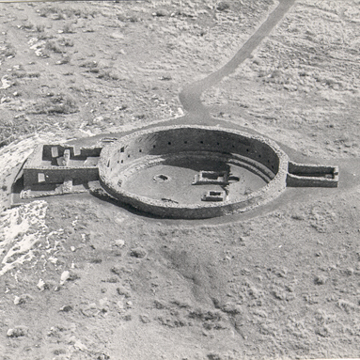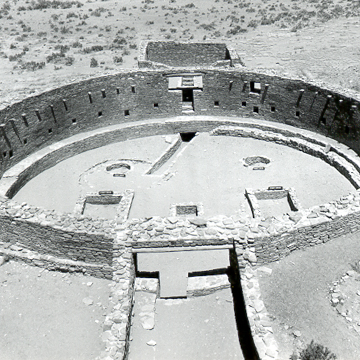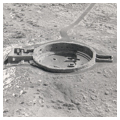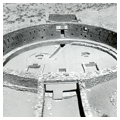Casa Rinconada (Spanish for “house in the corner”) is one of the largest great kivas ever built and is one of the principal ceremonial structures in Chaco Canyon.
At 64 feet in diameter, Casa Rinconada is the third-largest Chacoan great kiva (after the 67-foot-diameter Aztec East Ruin and the 74-foot-diameter Peñasco Blanco). It is symmetrical along a central north-south axis that deviates from true north by one degree. The partially subterranean structure, with veneer-and-core sandstone walls, is entered from the north and south through antechambers with T-shaped doors and stairs that step down to the kiva floor. Three to six ancillary rooms surround the north antechamber, and it is possible that surface rooms ran all the way around the kiva exterior. Underneath the north entrance, a secondary entryway accesses a 39-foot-long masonry-lined tunnel that leads to flagstones arranged in a spiral pattern; this might have been used for entrances and exits during ritual performances.
Casa Rinconada has two circumferential benches set on top of each other, the original lower bench and an upper bench added at a later date. Set into the wall above the benches are two groups of niches: a higher ring of 28 niches, which may refer to the lunar month of 28 days, and six more niches below, two on the east side and four on the west side, one of which may be a solstice marker. The roof beams rested on four wood columns, each seated on two to four massive stone disks (weighing approximately 1,000 pounds each) sunk three feet below the floor. It is unclear whether the roof covered the entire interior or was left open to the sky in the center. Between the columns, a pair of raised floor vaults flanked an elevated firebox, which was backed and protected to the south by a vertical deflector.
Large, circular pit structures began to appear in the Four Corners region by at least the fifth century. Two examples dating to this time, measuring 32 and 39 feet in diameter, respectively, have been found in Chaco Canyon villages. Those built before circa 800 appear to have served as meeting places, and some archaeologists have theorized that they were the antecedents to the great kivas in Chaco Canyon. Great kivas began to appear in the early ninth century.
There are at least 22 great kivas in Chaco Canyon, ranging in size from 33 to 75 feet in diameter (measured above each structure’s masonry bench). These kivas are either located in first-order great houses, along the north side of Chaco Canyon, or stand in isolation on the canyon’s south side of Chaco Canyon; the four isolated kivas, including Casa Rinconada, probably functioned as spaces for regional and empire-wide ideological, religious, and/or political rituals. Casa Rinconada is located within a half-mile of Pueblo Bonito and Chetro Ketl, the two central great houses in Chaco Canyon, and forms a triad with Great Kiva A in Pueblo Bonito and the Great Sanctuary kiva in Chetro Ketl. A formalized road leads directly from Casa Rinconada through the gap between the two large platform mounds on the south side of Pueblo Bonito, and it seems likely that the two structures were ritually connected.
Archaeological evidence indicates that great kivas were ritually closed when their functions were periodically moved to newer great kivas. The four great kivas at Pueblo Bonito, located in the central plaza along its north-south spine, were used serially (in a counterclockwise rotational sequence) and the latest one was ultimately lined with a coarse rubble veneer and burned. There is some evidence that Casa Rinconada was closed in the same way.
References
Van Dyke, Ruth M. “Great Kivas in Time, Space, and Society.” In The Architecture of Chaco Canyon, edited by Stephen H. Lekson, 93-126. Salt Lake City: University of Utah Press, 2007.
Vivian, Gordon, and Paul Reiter. Great Kivas of Chaco Canyon and their Relationships. Monograph No. 22. Albuquerque: University of New Mexico Press/School of American Research, 1965.




